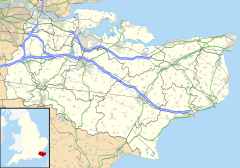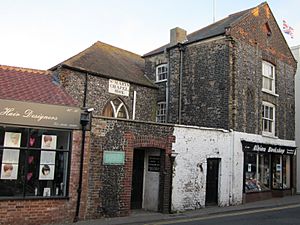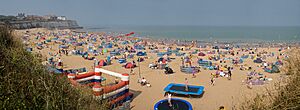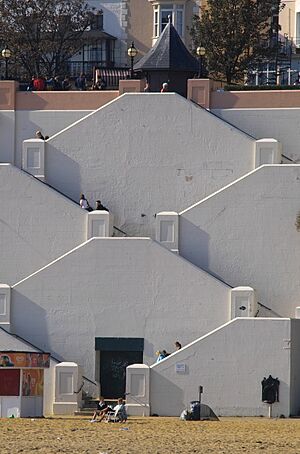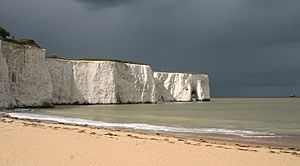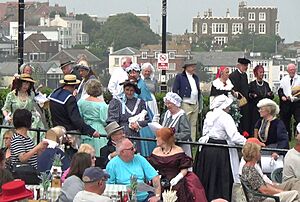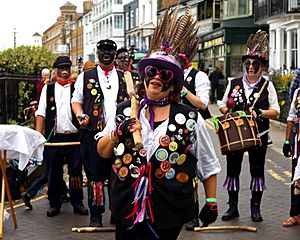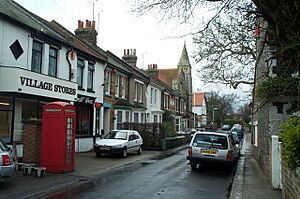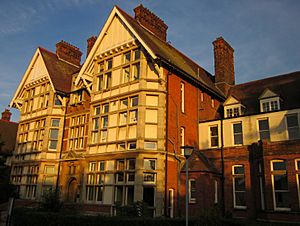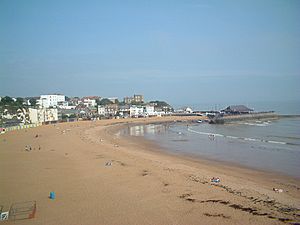Broadstairs facts for kids
Quick facts for kids Broadstairs |
|
|---|---|
 Viking Bay, Broadstairs |
|
| Population | 24,903 (Broadstairs and St Peter's parish 2011) |
| OS grid reference | TR395675 |
| • London | 81.6 miles (131.3 km) |
| Civil parish | |
| District |
|
| Shire county | |
| Region | |
| Country | England |
| Sovereign state | United Kingdom |
| Post town | Broadstairs |
| Postcode district | CT10 |
| Dialling code | 01843 |
| Police | Kent |
| Fire | Kent |
| Ambulance | South East Coast |
| EU Parliament | South East England |
| UK Parliament |
|
Broadstairs is a lovely coastal town in Kent, England. It's located on the Isle of Thanet, which isn't really an island anymore, but a peninsula. Broadstairs is about 130 kilometers (80 miles) east of London.
It's part of a larger area called Broadstairs and St Peter's, and in 2011, about 25,000 people lived here. Broadstairs is famous as a seaside resort, known for its beautiful beaches. The town's motto, Stella Maris, means "Star of the Sea" in Latin. The name "Broadstairs" comes from old steps cut into the chalk cliffs. These steps led from the sandy beach up to a special religious place called the Shrine of Our Lady, Bradstowe on the cliff top.
The town stretches from Haine Road in the west to Kingsgate in the north. Kingsgate was named after King Charles II landed there in 1683. To the south, you'll find Dumpton. There's also a small area called Reading Street, which was settled by refugees from Flanders in the 1600s.
Contents
- A Look Back: Broadstairs History
- How Broadstairs is Governed
- Broadstairs' Location and Nature
- People and Jobs in Broadstairs
- Economy: How Broadstairs Makes Money
- Culture and Community Life
- Famous Places and Sights
- Getting Around: Transport
- Learning in Broadstairs: Education
- Places of Worship
- Sports and Activities
- News and Media
- Famous People from Broadstairs
- See also
A Look Back: Broadstairs History
The village of St Peter's, which is inland from the coast, started around 1080. This was when its parish church was built. In the Middle Ages, St Peter's was part of a group of important coastal towns called the Cinque Ports.
Near the coast, there was a special religious place called the Shrine of Our Lady. It was on the cliffs at a spot then known as Bradstow(e), meaning "broad place." This name probably referred to the wide bay below.
A fishing village grew near the shrine in the 1300s. This village became known as "Broadstairs" because of the steps built into the cliff. These steps made it easier to reach the shrine from the bay.
From the 1400s to the 1700s
Around 1440, an archway was built across a path leading to the sea. The first wooden pier, or jetty, was built in 1460. A stronger pier was built in 1538. The road to the seafront, called Harbour Street, was also cut into the chalk cliffs around this time.
In 1540, the York Gate was built. This gate still stands across Harbour Street today. Back then, it had heavy wooden doors that could be closed to protect the town from dangers coming from the sea.
The 1700s and Early 1800s
By 1823, Broadstairs had about 300 people. The pier was very important for fishing boats. Fish catches from far away places were brought here. In 1767, a big storm almost destroyed the pier. But because it was so important, other towns and companies helped pay to fix it in 1774.
In 1795, the York Gate needed repairs to protect against threats during the French Revolutionary Wars.
A famous event happened in 1815. Major Henry Percy landed in Thanet with a captured French flag from the Battle of Waterloo. To remember this, a tunnel and stairway from the beach to the cliff tops was dug. It was named "Waterloo Stairs."
Smuggling was a big business in the area. People in Broadstairs and St Peter's were very good at hiding illegal goods like tea, spirits, and tobacco. There are many secret tunnels and caves in the chalk cliffs that smugglers used.
Broadstairs Becomes a Seaside Resort
Around 1824, steamboats became popular. They made travel from London much faster than the old sailing boats. This brought new visitors and money to Broadstairs.
Even the young Princess Victoria and her mother visited Broadstairs for their summer holidays from 1826 to 1836. They stayed at a place called Pierremont Hall.
By the mid-1800s, more people were moving to Broadstairs. The population reached about 3,000 by 1850. Because of the fresh sea air, many homes for sick children opened in the late 1800s.
Even though many holidaymakers came to Broadstairs, trains didn't arrive directly until 1863. Before that, people had to take coaches to other train stations. The first railway in England, with its famous engine Invicta, started in nearby Whitstable in 1830.
By the 1840s, smuggling had stopped. Broadstairs continued to grow as a popular holiday spot.
By 1910, about 10,000 people lived in Broadstairs. The town has kept many of its historical features, including its interesting maritime history and important religious history.
How Broadstairs is Governed
Broadstairs is part of the Thanet District for local government. The town is divided into five areas called electoral wards: Bradstowe, St Peter's, Beacon Road, Viking, and Kingsgate. These wards have 11 of the 56 seats on the Thanet District Council.
After the 2023 local elections, the political groups changed. The Conservative Party lost some seats, while the Labour Party and the Green Party gained seats. There's also an Independent council member. The Broadstairs and St Peter's Town Council has 15 members, who are elected every four years. They are led by the mayor.
The local MP (the person who represents the area in the UK Parliament) for East Thanet is Polly Billington from the Labour Party. She became the MP after the 2024 general election.
Broadstairs and St Peter's have been "twinned" with Wattignies in northern France since the 1980s. This means they have a special friendship and cultural exchange.
Broadstairs' Location and Nature
The town sits above a harbour with cliffs on both sides. It has seven golden sandy bays. From south to north, they are: Dumpton Gap, Louisa Bay, Viking Bay, Stone Bay, Joss Bay, Kingsgate Bay, and Botany Bay. A headland called North Foreland is located between Stone Bay and Joss Bay.
On the cliffs above Kingsgate Bay, you can see Kingsgate Castle. It used to be part of a large estate but has now been turned into private homes.
Broadstairs has a very mild maritime climate, meaning it has gentle weather because it's by the sea.
People and Jobs in Broadstairs
Broadstairs and St Peter's had 24,370 residents in 2001. Most people (97.9%) were white. About 94.7% of residents were born in the United Kingdom. Most people (75.3%) were Christian.
The age distribution shows that a high percentage of residents are over 65 (24%). This is because seaside towns are popular places for people to retire.
Jobs in Broadstairs
In 2001, many residents worked full-time (34.1%) or part-time (12.8%). About 10% were self-employed. Only 2.9% were unemployed, which is a low number. A large number of people (20%) were retired.
The main industries for jobs in 2001 were retail (shops), health and social work, manufacturing, and education. Broadstairs has many schools and colleges, which provide a lot of jobs. Many people also travel outside the town for work.
Economy: How Broadstairs Makes Money
Since Broadstairs is a seaside resort, its economy mostly depends on tourism. There are many hotels and guest houses near the seafront for visitors. While some hotels have closed, the ones that remain have improved in quality.
The High Street has many unique local shops. There are also some factories on industrial estates outside the town. Because many older people live here, there are also many jobs in health and social care at local care homes.
- The Broadstairs' & St Peter's Chamber of Commerce helps local businesses and promotes tourism.
- The largest industrial area is at Pyson's Road.
- It's hard to find land to build new homes in Broadstairs, so property prices are often higher here than in other parts of Thanet.
- Broadstairs has seen big changes with the building of Westwood Cross, a large shopping area outside of town. It has many big shops, a hotel, a cinema, and restaurants.
- There are three large supermarkets in Broadstairs: Asda, Sainsbury's, and a Tesco Extra. There's also a smaller Tesco and a Co-op.
- Saga Insurance Ltd. manages some of its insurance claims from offices in Broadstairs.
Culture and Community Life
Broadstairs has a small cinema called "The Palace Cinema" on Harbour Street.
- The Broadstairs Dickens Festival happens every year in June. It celebrates the famous writer Charles Dickens, who loved Broadstairs. People dress in Victorian clothes, and there's a play based on one of Dickens' novels. The festival started in 1937.
- In August, the town hosts the Broadstairs Folk Week music festival. Main concerts are held in Pierremont Park. Smaller music events take place in pubs, restaurants, and at the town's bandstand. Musicians and Morris dancers perform along the beach promenade. This festival brings many tourists to the town.
- During the summer and on November 5th, there are firework displays every Wednesday evening over Viking Bay.
- In August, the town also has an annual Water Gala. This event includes beach competitions, shows, a funfair, and sometimes an air display.
- In St Peter's village, you can take tours during the summer.
- A newer event is the Big Broadstairs Weekend in May. It includes a dance, a film on the beach, and a try at a Guinness World Record. Broadstairs currently holds the record for the biggest remote dance class!
Famous Places and Sights

The beaches at Botany Bay and Joss Bay received the Blue Flag award in 2005. Viking Bay, the main beach in Broadstairs, won the Blue Flag in 2006. In summer, Viking Bay is very popular with tourists. The Pavilion on the Sands, located on Harbour Street, offers shows and entertainment with great views of the bay. It's also a popular place for weddings.
The Dickens House Museum on the seafront has many items related to Charles Dickens and his time in Broadstairs. Crampton Tower, near the railway station, is a museum about Thomas Russell Crampton, a railway engineer. It shows his drawings, models, and how railways and trams developed. You can also see the original Broadstairs stagecoach from 1860 and seven model railways.
Getting Around: Transport
Broadstairs is about 32 kilometers (20 miles) from Dover and Canterbury. It's also about 108 kilometers (67 miles) from the M25, which is London's main ring road.
The Broadstairs train station is about a 10-minute walk from the beach. In 2009, a new high-speed train service started. It connects Broadstairs to London St Pancras much faster, cutting about 40 minutes off the journey.
Lifeboats
Lifeboats have been in Broadstairs since 1851. These boats are used to rescue people at sea. One of the first lifeboats, the Mary White, was used in 1851 to rescue a ship called the Mary White that was stuck on the Goodwin Sands.
Another important lifeboat was the "Frances Forbes Barton." It was stationed in Broadstairs from 1897 to 1912. During that time, it launched 77 times and saved 115 lives!
Learning in Broadstairs: Education
State Schools
For Younger Students:
- St Mildred's Infant School
- Upton Junior School
- St Peter in Thanet CE Junior School
- St Joseph's RC Primary School
- Bromstone County Primary School
For Older Students:
- Dane Court Grammar School
- St Georges C of E Foundation School
- The Charles Dickens School
- Chatham House Grammar School
- Clarendon House Grammar School
Special Schools
- Bradstow School
- Stone Bay School
Independent Schools
For Younger Students:
- St Lawrence College, Junior School
- Wellesley Haddon Dene School
For Older Students:
- St Lawrence College
Colleges and Universities
- East Kent College
- Canterbury Christ Church University
Places of Worship
The original Shrine of Our Ladye Star of the Sea is very old, possibly from the 1000s. The chapel was damaged in the 1500s but was rebuilt in 1601. The Roman Catholic Church of Our Lady Star of the Sea in Broadstairs is named after this shrine.
The main Anglican church is Holy Trinity, built in 1830. The church of St. Peter-in-Thanet has one of the longest churchyards in England.
Sports and Activities
- Thanet Wanderers Rugby Union Football Club is based in Broadstairs.
- There's an annual sandcastle building competition.
- Broadstairs has a Green bowling club.
- Broadstairs & St Peter's Lawn Tennis Club is great for tennis.
- Beach volleyball is played on the beach in summer.
- Broadstairs is home to the North Foreland Golf Club.
- Broadstairs Sailing Club once had former prime minister Edward Heath as a member.
- Broadstairs also has a squash club.
Swimming in the Sea
Swimming in the sea is very popular, especially at Viking Bay. Lifeguards are on duty during the summer. The famous writer Charles Dickens used to swim here!
At high tide, the water gets deep quickly. At middle and low tides, the beach slopes gently, making it fun to play in the shallow water. Swimmers should stay within the marked areas of the bay. If you swim outside these areas, you might find strong currents. If you get into trouble, it's best to swim directly towards the nearest shore.
Stone Bay, north of Viking Bay, also has a lifeguard in summer and is popular for swimming year-round.
News and Media
Broadstairs has one paid-for newspaper, the Isle of Thanet Gazette. Its sister paper, the Thanet Times, closed in 2012. Free newspapers include the Thanet Extra and yourthanet. Isle magazine is published four times a year and lists local events and tourist information. The Broadstairs Beacon magazine is published three times a year and is available for free.
Local radio stations include KMFM Thanet and community radio station Academy FM (Thanet). There are also county-wide stations like Heart Kent and BBC Radio Kent. Thanet Community Radio offers online podcasts for the area.
Famous People from Broadstairs
People from Broadstairs are sometimes called Bradstonians.
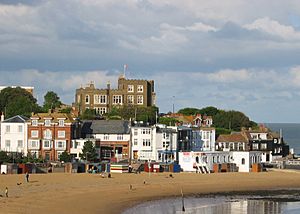
- William Bridges Adams, an engineer who invented the Adams Axle, died in Broadstairs in 1872.
- Sir Richard Rodney Bennett, a composer and pianist, was born in Broadstairs in 1936.
- John Buchan supposedly got the idea for his novel The Thirty Nine Steps from a set of steps on the beach in Broadstairs.
- Thomas Russell Crampton, a railway engineer, was born in Broadstairs in 1816.
- Charles Dickens visited Broadstairs often from 1837 to 1859. He called it "Our English Watering Place." He wrote David Copperfield while staying at Bleak House.
- Tim Edey, a musician and composer, grew up in Broadstairs.
- Sir Edward Heath, who was the Prime Minister of the United Kingdom from 1970 to 1974, was born in Broadstairs in 1916.
- Oliver Postgate, who created the Clangers animated TV series, lived in Broadstairs for a long time. There's a mosaic of the Clangers and a blue plaque on his old home.
- Writer and filmmaker Bruce Robinson set his novel The Peculiar Memories of Thomas Penman in Broadstairs. He is from the town, and the book is partly about his childhood there.
- Tallulah, a DJ, studied in Broadstairs.
See also
 In Spanish: Broadstairs para niños
In Spanish: Broadstairs para niños


